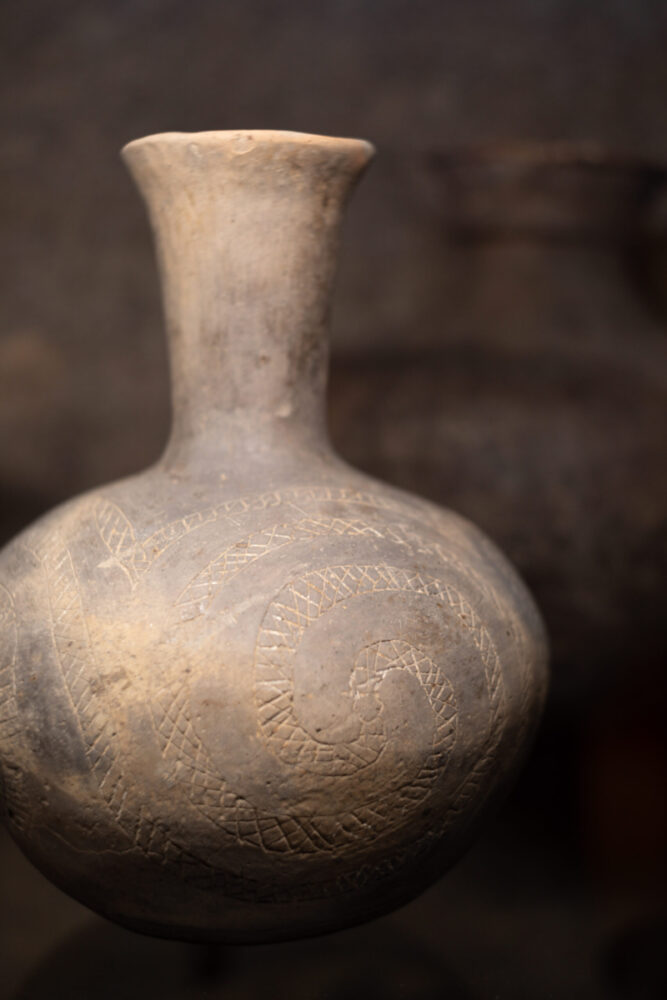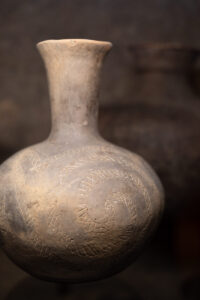Tunica-Biloxi Tribe
The Tunica-Biloxi Tribe is one of only four American Indian groups in Louisiana recognized by the federal government.
This entry is High School Civics level View Full Entry

The Louisiana Endowment for the Humanities
An incised clay vessel found with the "Tunica Treasure." Brian Pavlich, photographer.
The Tunica-Biloxi Tribe of Louisiana is one of four federally recognized American Indian tribes in the state. As of 2023 there are approximately 1,500 enrolled tribal members spread throughout Louisiana (45 percent), Texas (29 percent), Illinois (8 percent), and other parts of the United States (18 percent). The Tunica-Biloxi Tribe traces its roots back to the historic Tunica, Biloxi, Ofo, and Avoyel Tribes. These allied tribes became unified into a single tribe in the early twentieth century. The Tunica-Biloxi reservation is located just south of Marksville in east-central Louisiana. Tribal lands include approximately 1,717 acres of trust and fee property in Avoyelles and Rapides Parishes. (Trust land is land that the US government holds in trust, maintaining a title on behalf of a federally recognized tribe. Fee-simple land is land held under complete control by a tribe to lease or develop as they see fit.)
How did Tunicas, European settlers, and other groups interact in colonial Louisiana?
Historians generally agree that a group of Spanish explorers, under the leadership of Hernando de Soto, encountered Tunica ancestors in the province of Quizquiz (present-day northwestern Mississippi) in 1541. Quizquiz’s Indigenous inhabitants built mounds like those found throughout the Mississippi Valley. Their military and agricultural capabilities impressed the Spanish. Spanish explorers transmitted diseases that decimated Indigenous populations. Little is known about the period following de Soto, as continued interactions with French and Spanish colonists disrupted the Tunica language and oral traditions. The first recorded encounter between the French and Tunicas occurred in 1699.
Tunicas made a broad impact on trade and culture in Arkansas, Louisiana, and Mississippi throughout the eighteenth century. Tunicas were skilled traders and entrepreneurs, especially in the manufacture and distribution of salt. The French relied heavily on the tribe for salt, rice, cattle, and horses. The French also looked to Tunicas for military support against rival tribes such as the Natchez and Chickasaws.
Tunicas migrated to the Red River-Mississippi River intersection after coming in conflict with the Chickasaws and English. They resettled among the Houmas in an area known as Portage de la Croix (near present-day Angola, Louisiana). Tunicas attacked their Houma hosts in 1706 to build trade and diplomatic ties with the French. In 1731, following the 1729 Natchez revolt, a group of Natchez refugees attacked the main Tunica village. Several chiefs were killed and the defeated tribe migrated once again to a tributary of the Mississippi River that is known today as Tunica Bayou.
After the 1763 Treaty of Paris, the tribe left Tunica Bayou after coming in conflict with British forces and allying with the new Spanish regime in New Orleans. In 1764 they settled on the east side of the Mississippi River near Pointe Coupée. Approximately twenty years later, Tunicas moved to the interior of Spanish Louisiana in present-day Avoyelles Parish. Since the 1780s the tribe’s main settlement has remained in Marksville, Louisiana.
How did the Louisiana Purchase and interactions with the United States affect the Tunica and Biloxi peoples?
After the 1803 Louisiana Purchase, the United States committed itself to a policy of protecting American Indian land and rights. In reality the government disregarded the smaller Louisiana tribes in favor of placating former French and Spanish colonists. Once afforded respect and protection by Spain as a sovereign nation, Tunicas lost their land to French and American settlers. In an 1806 report to the US government, American Indian agent John Sibley dismissed most Louisiana tribes as insignificant “remnants.” Thus, Tunicas escaped the Indian removal policy of the 1830s and 1840s and kept their village on the Avoyelles Prairie.
Following the Civil War Tunicas lived in farming communities in and around Marksville. The tribe made an official land claim during the 1890s, but the Louisiana Supreme Court ruled against the tribe. In 1920 another state court ruling found “no official recognition that would segregate [Tunicas] from the rest of the population of the state.” In response to state and federal government rejection, as well as a decline in the number of self-identified people of Tunica descent, Tunicas merged with several other historical Louisiana tribes—including the Biloxi, Avoyel, Ofo, and Choctaw Tribes—to pool their political, cultural, and economic resources for future attempts at official recognition.
Beginning with tribal leader Sesostrie Youchigant in 1911, the Tunica village in Marksville maintained a formal system of electing their chief, recording the elections in the parish courthouse. Youchigant resigned in 1921, making way for the election of Ernest Pierite as chief and Eli Barbry, Youchigant’s half-brother, as subchief. During Pierite’s time as chief, Tunicas and Biloxis formally joined. On October 9, 1924, the Biloxis recognized Eli Barbry as the leader and authorized him to bring about a union of Tunicas and Biloxis. The death of Sesostrie Youchigant in 1948 marked a decline in use of the Tunica language and fading of many traditions.
How has the Tunica-Biloxi Tribe developed economically, politically, and culturally in recent history?
Tunicas received considerable attention during the 1970s when Leonard Charrier, an amateur archaeologist, excavated thousands of burial objects associated with the Tunica Bayou settlement. Dubbed the “Tunica Treasure” but more formally referred to as the Trudeau site, Harvard researcher Jeffrey Brain and a team of professional archaeologists conducted extensive excavations there in 1972, 1980, and 1981. They uncovered artifacts of Indigenous and European origin, including pottery, basketry, glass beads, ceramic bowls, axes, nails, scissors, jewelry, firearms, and more. Most items were found on or near the bodies of Tunica men, women, and children buried in traditional fashion.
During the 1970s, leaders of what remained of the coalition of Tunicas and Biloxis decided to pursue federal recognition as a tribe. Earl J. Barbry Sr. was elected tribal chairman in 1978, after which he became the main force behind an appeal to the US Bureau of Indian Affairs for acknowledgement of the Tunica-Biloxi Tribe of Louisiana. Federal recognition of the tribe came in 1981 after leaders demonstrated the following information to the federal government: existence of a distinct American Indian community going back several centuries to first contact with Europeans; identification of a distinct American Indian group since first contact by federal governments, state governments, local governments, other tribes, or scholars; and proof of ancestral links to the historic tribe from which the present one descended. Moreover, Barbry was partly responsible for securing the return of the “Tunica Treasure” to the Tunica-Biloxi Tribe in 1989 in accordance with a state court ruling.
After receiving federal recognition, the Tunica-Biloxi Tribe set out to secure economic independence for its people. Progress was slow until the Grand Casino Avoyelles, now Paragon Casino Resort, opened in 1994. The casino and associated hotel, golf course, and entertainment venues are among the largest employers in the region. Other tribal enterprises include a film finance and production company and an online lending company.
The tribe is governed by a seven-person council including a chairman, vice-chairman, secretary-treasurer, and four at-large council members. Every council member serves a four-year term; terms are staggered with tribal elections every two years. The Tunica-Biloxi Tribe began electing its current form of council in 1976.
In 1998 tribal leaders started the Tunica-Biloxi Indian Political Action Committee to influence state and federal legislation. The administration of the Tunica-Biloxi Tribe includes departments devoted to health, housing, gaming, finances, cultural resources, legal affairs, social services, and education. In 2011 the tribe opened the forty-thousand-square-foot Tunica-Biloxi Cultural and Educational Resources Center, which includes a museum housing the Tunica Treasure, a gift shop, conservation lab, library, auditorium, distance-learning center, classrooms and meeting rooms, and tribal government offices.
The tribe’s Language and Culture Revitalization Program, created in 2014, provides structural support for language and culture education, as well as a noticeable presence of heritage languages on the reservation and throughout the extended community. Tribal culturalists maintain the tradition of pine needle basketry and beadwork and preserve songs and stories passed down by community elders. The Tunica-Biloxi Nature Trail, a one-mile boardwalk, extends from the casino and administrative complex into the undeveloped natural setting of Coulee des Grues. The Tunica-Biloxi Powwow is held annually on the third weekend in May, with an “Education Day” featuring interpretive programming and dance demonstrations held the Friday before the powwow begins on Saturday. Though most members of the tribe don’t reside on tribal lands, many participate in cultural life through tribal meetings and the annual powwow. Tribal programs and facilities enhance the quality of life for Tunica-Biloxi people and provide educational opportunities, housing, and medical services.
The resilience of the Tunica-Biloxi people to disease, warfare, displacement, and resettlement is a testament to the tribe’s collective ability to adapt to the social, cultural, and economic upheavals that came with more than four hundred years of colonial activity. Their legacy as entrepreneurs, diplomats, and good neighbors continues today.
